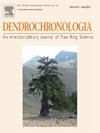用变化点检测法校正蓝色强度测量中的心材-边材过渡
IF 2.7
3区 农林科学
Q1 FORESTRY
引用次数: 0
摘要
δ蓝强度是一种常用的方法来纠正心材-边材的颜色变化的蓝色强度(BI)测量。它是基于假设心材和边材的颜色变化在早木和晚木中是相似的。这一假设尚未得到生理学上的支持。此外,三角洲BI可能会混淆早坞和晚坞BI的气候信号,因为它在技术上是另外两者的线性组合。在这里,我们没有使用delta BI,而是使用变化点检测来识别心材-边材的过渡,并通过将过渡后的BI测量值的均值和方差重新缩放到之前的值来校正颜色变化。我们测试了三种不同的变化点检测方法,发现它们之间的一致性很好。重要的是,我们的方法保留了早期和晚期wood BI数据中的气候信号,而delta BI在我们的测试用例中导致气候信号的完全丢失。因此,我们建议使用变化点检测来代替delta BI来解释心材-边材的颜色变化。本文章由计算机程序翻译,如有差异,请以英文原文为准。
Correcting the heartwood-sapwood transition in blue intensity measurements with change point detection methods
Delta blue intensity is a commonly used method to correct for the heartwood-sapwood color change in blue intensity (BI) measurements. It is based on the assumption that the heartwood-sapwood color change is similar in both earlywood and latewood. This assumption has not been supported physiologically. Furthermore, delta BI may confound the climate signals in earlywood and latewood BI as it is technically a linear combination of the other two. Here, instead of using delta BI, we used change point detection to identify the heartwood-sapwood transition, and corrected for the color change by rescaling the mean and variance of BI measurements after the transition to those immediately before. We tested three different change point detection methods and found that they agreed well with one another. Importantly, our approach preserves the climate signals in both earlywood and latewood BI data, while delta BI causes a total loss of climate signals in our test case. Therefore, we suggest that change point detection should be used instead of delta BI to account for the heartwood-sapwood color change.
求助全文
通过发布文献求助,成功后即可免费获取论文全文。
去求助
来源期刊

Dendrochronologia
FORESTRY-GEOGRAPHY, PHYSICAL
CiteScore
5.50
自引率
13.30%
发文量
82
审稿时长
22.8 weeks
期刊介绍:
Dendrochronologia is a peer-reviewed international scholarly journal that presents high-quality research related to growth rings of woody plants, i.e., trees and shrubs, and the application of tree-ring studies.
The areas covered by the journal include, but are not limited to:
Archaeology
Botany
Climatology
Ecology
Forestry
Geology
Hydrology
Original research articles, reviews, communications, technical notes and personal notes are considered for publication.
 求助内容:
求助内容: 应助结果提醒方式:
应助结果提醒方式:


